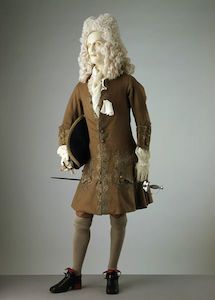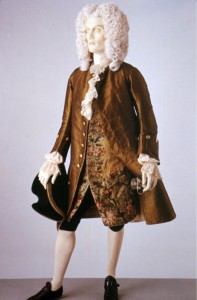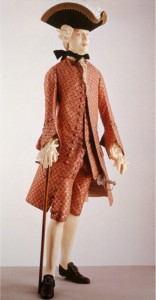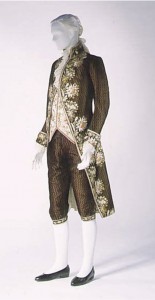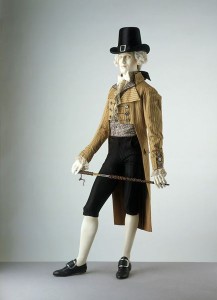“The coat, waistcoat and breeches remained the primary ensemble for men’s formal and informal dress throughout the 18th century. This coat dates from the early decades of the 1700s. The muted shade of brown in a fine wool is typical for the date and for English men’s dress, as is the silver-gilt embroidery. Up until the 1730s, coats were knee-length, buttoning right to the hem, with full pleats at the sides. The cuffs were altered to the ‘mariner’s’ style of the 1750s, suggesting that the coat may have been worn by two generations of owners.
According to family lore, the coat was worn by Thomas Severne Esq. (1644–1737), who was Gentleman of the Bedchamber to William III (reigned 1689–1702).”
“This coat and waistcoat illustrate formal daywear for men in the 1740s. The fabric of the coat is a rich shot green and black silk. By the 1740s the waistcoat is shorter in length than the coat. It is made of yellow silk brocaded with coloured silk and silver threads. Comprised of large flowers and leaves densely covering the fabric, the brocaded pattern is typical of Late Baroque design. The coat is collarless. It fits tightly to the body, but has very full skirts pleated to the sides at the hip. The sleeve cuffs are wide, reaching about half way to the elbow. Typical of the early 18th century, the waistcoat is also sleeved, although this style was beginning to go out of fashion by the 1740s.”
“At the beginning of the 18th century the male silhouette differed greatly from that of today. A typical outfit consisted of a full-skirted knee-length coat, knee breeches, a vest or long waistcoat (which could be sleeved), a linen shirt with frills and linen underdrawers. Lower legs showed and were an important part of the silhouette. Men wore silk stockings and leather shoes with stacked heels of low or medium height. The whole ensemble would have been topped by a shoulder-length full-bottomed wig and a tricorne (three-cornered) hat with an upturned brim.
As the century progressed, the male silhouette slowly changed. By the middle of the century the wig was usually tied back (known as the tye or bag wig). By the end of the century it was out of fashion altogether except for the most formal occasions. Undergarments and knee breeches did not change very much. Coat skirts gradually became less full and the front was cut in a curved line towards the back. Waistcoats became shorter. The upper leg began to show more and more and by the end of the century breeches fitted better because they were often made of knitted silk. Shoes became low-heeled with pointed toes and were fastened with a detachable buckle and straps or ribbon on the vamp (the upper front part of a boot or shoe).”
“This formal suit, made or worn with a contrasting waistcoat, handsomely shows the richness of embroidery added to the luxury of patterned silk velvet. The height of the collar and the narrowness of the sleeves, cuffs, and coat fronts date this suit to the fourth quarter of the eighteenth century. Suits of this general type were retained for court wear well into the nineteenth century.”
“By the 1780s waistcoats had lost their skirts and were cut straight across at the lower hem, for all but evening and Court dress. A small collar appeared, echoing the development of the coat collar, and by the 1790s it had grown to the generous size seen here, with large revers (lapels). The double-breasted style, in both coats and waistcoats, was also a fashion that began in the 1780s. A network of violet and cream-coloured silk ribbons has been applied to this waistcoat, with buttons embroidered in the same colours to match.”
